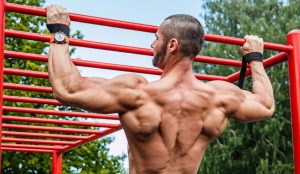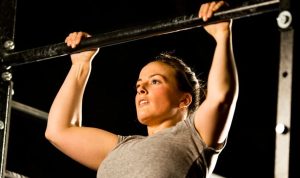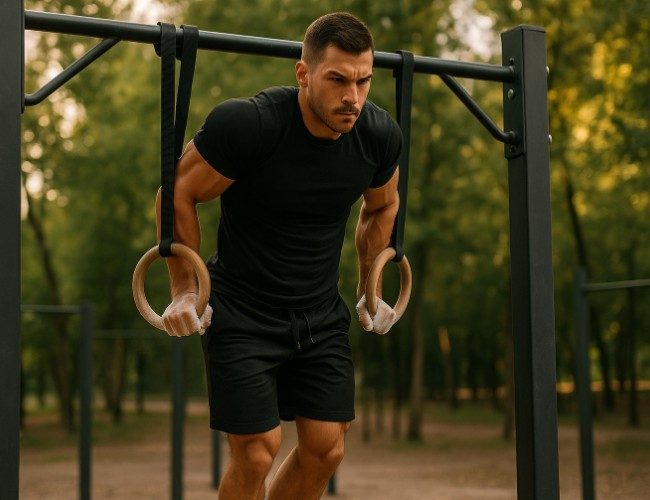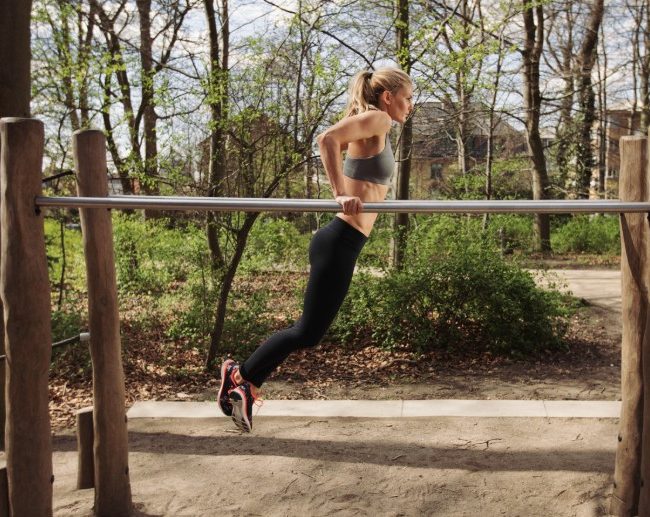
Pull Day Workout – My Ultimate Guide: Build a Stronger Back, Biceps & Grip With Bodyweight & Equipment
Pull day changed everything for me. It didn’t just build my back and arms, it rewired the way I train, how I think about functional strength, and the connection I have with my body.
Whether I’m doing bodyweight-only routines or mixing in dumbbells and bands, pull training gives me some of the most noticeable results.
Let me walk you through exactly how I approach pull day, with all the details, exercises, muscles worked, mistakes I’ve made, and how I’ve structured my routine to maximise gains.
What Is a Pull Day Workout and Why Does It Matter?

Understanding the Push/Pull/Legs Split
The PPL split is a simple yet powerful way to organise your weekly training. On push days, I train muscles that push, chest, triceps, and shoulders. On leg days, it’s all lower body.
Pull days? They’re for all the muscles that pull, everything from my lats and traps down to biceps and grip. The beauty of this approach is how well it balances the workload. It gives each muscle group proper recovery while letting me train 5–6 days a week.
Muscles Targeted on a Pull Day
On pull day, my focus is on:
- Lats: The broad, wing-like muscles of the back. These give you that wide, V-shaped upper body.
- Trapezius: Especially the mid and lower traps, which help with posture and upper back development.
- Rhomboids & rear delts: These are stabilisers that pull the shoulder blades together.
- Biceps: Your elbow flexors, responsible for curling and pulling movements.
- Forearms & Grip: Often overlooked, but essential for strength and control.
Benefits of Pull Training for Strength, Posture & Balance
When I was new to training, I had that classic issue, too much pressing, not enough pulling. My shoulders slouched, and I couldn’t balance a push-up with a proper row.
As I committed to regular pull days, I noticed:
- Better posture
- Reduced shoulder pain
- More powerful and controlled movement in calisthenics
It’s not just about looking good from the back. It’s about building foundational strength that supports all movement.
Why I Prioritise Pull Day for Overall Upper Body Growth?
I used to think bench press was the ultimate upper body move, until I realised my pull-up strength was holding me back in everything else.
Prioritising pull day made me stronger, more symmetrical, and far more capable of mastering advanced skills like muscle-ups and front levers.
Which Muscles Do I Focus on During My Pull Day Workout?
Primary Muscles (Big Movers)
- Lats: The powerhouse of vertical pulling. I focus on engaging them with controlled pull-ups, not just rushing through reps.
- Traps: Mid and lower traps stabilise shoulder blades. I feel them especially during rows and face pulls.
- Biceps: I target them last, after compound pulling, so they assist rather than dominate.
Secondary Muscles (Supporting Cast)
- Rear delts & rhomboids: Crucial for posture and horizontal pulling (like rows).
- Forearms: I train these indirectly through grip work and directly with wrist curls, towel hangs, or rice bucket drills.
- Core: L-sit pull-ups and hanging raises hit my core hard even on pull day.
Vertical vs Horizontal Pulls: What’s the Difference?
Understanding this difference changed my training.
| Pull Type | Example Movements | Primary Focus |
| Vertical Pulls | Pull-ups, chin-ups, lat pulldowns | Lats, biceps, traps |
| Horizontal Pulls | Inverted rows, ring rows, band rows | Rhomboids, mid-traps, rear delts |
I always program both. If I skip rows, I feel it in my shoulder stability. If I skip pull-ups, I lose back width and pulling power.
My Pull Day Training Philosophy

Why Form and Control Matter More Than Volume?
I used to rush reps, thinking more was better. The truth? Controlled reps with mind-muscle connection yield better growth. Slowing down the eccentric phase (lowering) of a pull-up, pausing at the top, that’s where the gains live.
Training for Strength, Size & Mobility Simultaneously
Each pull day, I aim to:
- Build strength through challenging compound moves
- Stimulate muscle growth with volume
- Maintain mobility through shoulder-controlled articular rotations and scapular drills
It’s about combining goals rather than isolating them.
Progressive Overload Without Overcomplicating It
You don’t need fancy spreadsheets. Here’s how I progressively overload:
- Add reps or sets each week
- Slow down the movement
- Move to harder variations (e.g. from chin-ups to archer pull-ups)
- Increase time under tension
- Shorten rest times slightly
Choosing Between Bodyweight, Bands or Weights
I prefer bodyweight for control and function. But I supplement with:
- Bands for resistance and assistance
- Dumbbells for isolated biceps or traps
- Rings for instability and deeper engagement
My Go-To Pull Day Workout Routine
Dynamic Warm-Up for Pull Days
I always warm up for 7–10 minutes:
- Arm circles
- Resistance band shoulder activation
- Scapula push-ups
- Jumping jacks or rower to raise heart rate
Core Pull Movements I Never Skip
Pull-Ups
- 4 sets of 6–12 (varied grips)
- Focus: controlled reps, full range
Inverted Rows
- Great for beginners or burnout sets
- I use rings for added instability
Ring Rows or Dumbbell Rows
- I love these for hitting the mid-traps and rhomboids
Band-Assisted Pull-Ups
- For volume or when training skills like archer or typewriter pull-ups
Isolation Finisher Exercises
Once the big moves are done, I finish with:
- Resistance Band Curls – slow and strict
- Hammer Curls – great for brachialis
- Face Pulls – scapular health and rear delts
- Straight Arm Lat Pull-Downs – for lat activation
Grip and Forearm Burnout Set
Burner Example:
- Dead hang (1 min)
- Wrist curls (15 reps)
- Farmer’s hold (30 seconds)
- Repeat for 3 rounds
This set alone has improved my grip strength for moves like L-sits and bar hangs.
Cool Down and Mobility Focus
I use bands and slow movement to restore:
- Scapular retraction
- Neck mobility
- Shoulder joint range of motion
- Breathing to down-regulate after training
What Equipment Do I Use on Pull Day?

Must-Have Equipment
My top tools:
- Pull-Up Bar – my non-negotiable
- Rings – for deeper activation and flexibility
- Bands – assist hard moves or isolate smaller muscles
- Dumbbells – for bicep and forearm work
How I Modify Workouts With No Equipment?
| Goal | Equipment Version | No-Equipment Option |
| Vertical Pull | Pull-Ups | Towel Rows Over Door Frame |
| Horizontal Pull | Ring Rows or Dumbbells | Table Rows or Doorframe Rows |
| Isolation Curls | Dumbbell Curls | Towel Curls with Isometric Hold |
| Grip Strength | Farmer’s Carries | Rice Bucket Holds or Towel Twists |
Bodyweight Pull Day Workout for Calisthenics Focus
Complete Routine Example
- Pull-Ups (varied grip) – 4 sets of max effort
- Inverted Rows (feet elevated) – 3 sets of 10–12
- Archer Pull-Ups – 3 sets of 5–6 per side
- Towel Rows (under door or bar) – 2 sets to failure
- Dead Hangs – 3 rounds of 45–60 seconds
How to Progress Without Weights?
I increased intensity by:
- Changing lever length (e.g., straight legs vs bent knees)
- Using tempo (5-sec negatives)
- Adding volume over time
- Experimenting with archer and typewriter pull-ups
L-Sit Pull-Ups and Archer Pull-Ups
These are my favourite advanced moves. L-sit pull-ups work my abs and upper back. Archer pull-ups shift more load to one side, prepping for one-arm movements.
Grip Without Barbells
To train grip:
- Hang from towels
- Use a rice bucket
- Perform “wringing” towel drills
- Practice finger push-ups (beginner-friendly)
Common Pull Day Mistakes I’ve Learned to Avoid

Letting Biceps Dominate
I focus on pulling with my elbows, not hands. That mental cue hits the lats harder and prevents overtraining arms.
Using Momentum
If I’m swinging, I’m not growing. I keep it controlled, with 2–3 second negatives.
Neglecting Horizontal Pulls
I used to skip rows. But balancing vertical and horizontal pulls has improved my posture and reduced injury.
Forgetting Grip Work
Strong grip = more reps and more time under tension. I now train it intentionally.
Avoiding Pull Day Out of Weakness
Pull-ups were hard at first. But avoiding them delayed my growth. Now, I see them as essential.
Sample Weekly Push/Pull/Leg Split With Pull Day Placement
| Day | Focus | Main Movements |
| Monday | Push | Dips, Ring Push-Ups, Pike Push-Ups |
| Tuesday | Pull | Pull-Ups, Rows, Curls, Hangs |
| Wednesday | Legs | Bulgarian Splits, Nordic Curls |
| Thursday | Core/Rest | Hollow Holds, Hanging Raises, Stretching |
| Friday | Push (Volume) | Diamond Push-Ups, Wall HSPUs |
| Saturday | Pull (Skills) | L-Sit Pull-Ups, Archer Pull-Ups, Levers |
| Sunday | Rest | Full recovery, foam rolling |
I love having two pull days — one heavy, one skill-based.
Final Thoughts: Why Pull Day Became My Favourite Day?
Pull day tests your grit. It challenges your patience. But it also offers huge rewards. Every pull-up feels earned. Every new grip challenge feels like a milestone.
What started as my weakest day is now the one I most look forward to. It gave me posture, power, and pride in how I train. A well-structured pull day workout isn’t just about back and biceps. It’s about building strength, mobility, grip, and full-body control.
Whether you’re training with a bar, rings, dumbbells or just your own bodyweight, there’s no excuse to skip it. Focus on form, variety, and progressive challenge, and you’ll build a physique that’s as strong as it is functional.






